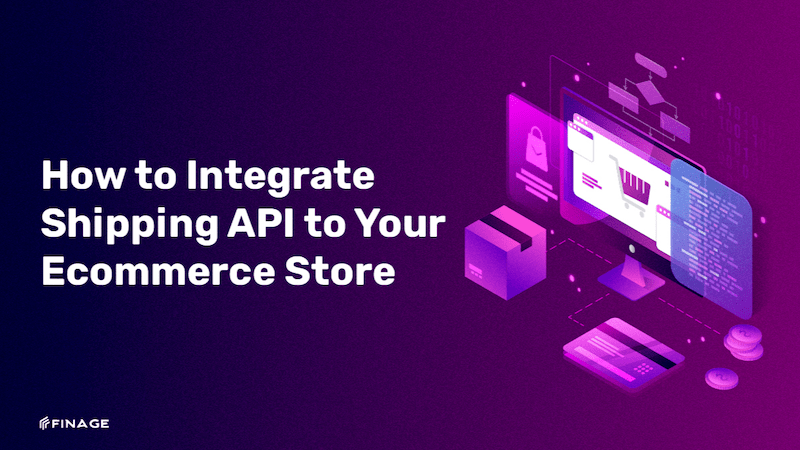How to Integrate Shipping API to Your E-commerce Store | API Guides
6 min read • December 19, 2022

Introduction
Application Programming Interface (API) is a type of programming software that facilitates communication between other forms of computer code. It's conceivable that each platform will have its own application programming interface (API) and possibly even its own suite of APIs. Every streaming website, social network, and weather app now has an API integration.
As the API economy has grown, information requests have rapidly replaced time-consuming manual data exchanges. This has serious implications for the order-fulfillment process, especially in the intricate world of shipping.
What exactly are application programming interfaces for shipping in online stores?
The information can then be used in a number of ways thanks to API connectors. That's the way API connections are implemented. Numerous eCommerce shipping companies keep their own APIs that e-commerce enterprises might use in order to streamline their delivery procedures. These shipping APIs allow your online store to communicate freely with shipping partners.
What does a shipping API perform, and why is it crucial for online retailers?
Given the current trends in online purchases, shipping APIs are becoming increasingly important for eCommerce for a number of reasons. Shipping APIs are able to perform a wide range of functions, including determining when packages will arrive and communicating any necessary delivery instructions. Orders may be shipped faster, turnaround times can be cut, and customer satisfaction increased with the right application of Shipping API interfaces. Therefore, knowing what functions API integrations provide is the first step in forming a collaboration with a new shipping partner. These are the primary responsibilities of Shipping APIs.
Making Purchases and Making AWBs
If you choose Two-Day Ground Shipping instead of Next-Day Air, then the information on your shipping label will ensure that your shipment arrives in two days. Shipping APIs strengthen the safety of this process by transmitting data directly to the relevant postal carrier. The courier then makes a new label and sends it back to the store. With this method, the retailer or 3PL merely needs to download and print labels, eliminating the requirement for time-consuming and error-prone data entry.
Keeping tabs on orders
Tracking orders efficiently is the luscious center of the sweet treat that is supply chain management, and every e-commerce business wants a piece. Multiple API integrations improve order monitoring efficiency. To track packages, several of these APIs can occasionally access third-party shipping tracking sites.
Thirdly, safe transport
Even in the best of circumstances, supply chain issues can arise and hurt a company's bottom line. When shipping APIs are integrated, however, you can be assured that a breach in your technology stack will not be the cause of any supply chain issues
APIs guarantee the safety and smooth transfer of your shipment data to other fulfillment software or partners.
Pricing analysis across multiple providers
When it comes to getting consumers' orders to them swiftly and affordably, e-commerce businesses may need to combine shipping alternatives based on the locations of their customers. When making an international purchase, when time is often traded for cost, this is especially true.
Handle Order Cancellations
Most carriers employ cancellation APIs to facilitate quick and successful reverse logistics for canceled orders. These cancellation API connections go into effect as soon as the e-commerce company receives and processes a cancellation request.
When an order is canceled, a new order is produced on the shipping partner page and the order is returned to the origin warehouse from the current delivery status. Once the order has been returned to the originating warehouse, the return path can be monitored to ensure that it was returned in one piece. After that, it might be restocked and sold to a customer in line.
Address validation is one of the most often used shipping application programming interfaces
Because they are fallible humans, your consumers sometimes make blunders when dealing with you. Included in this is the possibility that customers will mistype their addresses while making a purchase from your e-commerce platform. If you don't have the proper resources in place, this mistake won't cost you anything.
The price of a new mailing label is only one part of these costs. It also includes the time spent on extra orders, returns, and the potential loss of future business with that client as a result of the negative impression left by the service provided.
Address validation is a standard part of integrating your online shop with a shipping API. When a customer inputs their address during checkout, the API will automatically run in the background to verify that it is a legitimate address in the USPS database. It will also be simpler to tell the difference between a customer's home and place of business, which could influence how you handle deliveries in the future. There will be fewer opportunities for human error, the business will save money, and the customer experience will be improved.
Multiple-carrier compatibility
Each shipping company uses its own formula to figure out how much it will cost to transport your product given its dimensions, weight, origin, and destination. Since the item being shipped, the location of the delivery, and the buyer's patience all play a role in determining the optimal shipping method, these factors can all influence the final decision.
Using a shipping API that supports numerous carriers, you can easily compare shipping rates from different companies without having to go between sites. Even better, you may program it such that the fastest shipping method is always selected for one purchase and the lowest shipping method is always selected for another. You can save resources and speed up the fulfillment process for your business if you do this. Your clients will appreciate the flexibility provided by a shipping API, which can retrieve real-time rates from numerous carriers and display them to them.
The ability to monitor shipments
Think back to the last time you used the Internet to buy something. If you have ever had a package shipped to you, you know the frustration of trying to find out where it is in the shipping process. On average, online buyers make 3.5 visits per order to the respective order monitoring page.
Online shoppers count on being able to track their purchases in transit. The inbox of your customer service team will quickly fill up if you don't provide this option. You may improve your customers' post-purchase experience and keep in touch with them more efficiently by using a shipping API that provides tracking notifications. A shipping API's adaptability means it can integrate with your preexisting customer outreach tools, so you and your customers can stay in the loop with no further work on your part.
As was previously said, eCommerce APIs bring together data from multiple sources into a single view. The most popular approach is called REST architecture, and it involves an API "requesting" data from your server via HTTP and receiving a "response" in the same fashion. A finalized API will have accompanying API documentation that details the features and instructions for incorporating them into an existing system.
You can get your Real-Time and Historical Market Data with Finage free API key.
Build with us today!
Claim Your Free API Key Today
Access stock, forex and crypto market data with a free API key—no credit card required.

Stay Informed, Stay Ahead
Finage Blog: Data-Driven Insights & Ideas
Discover company news, announcements, updates, guides and more


